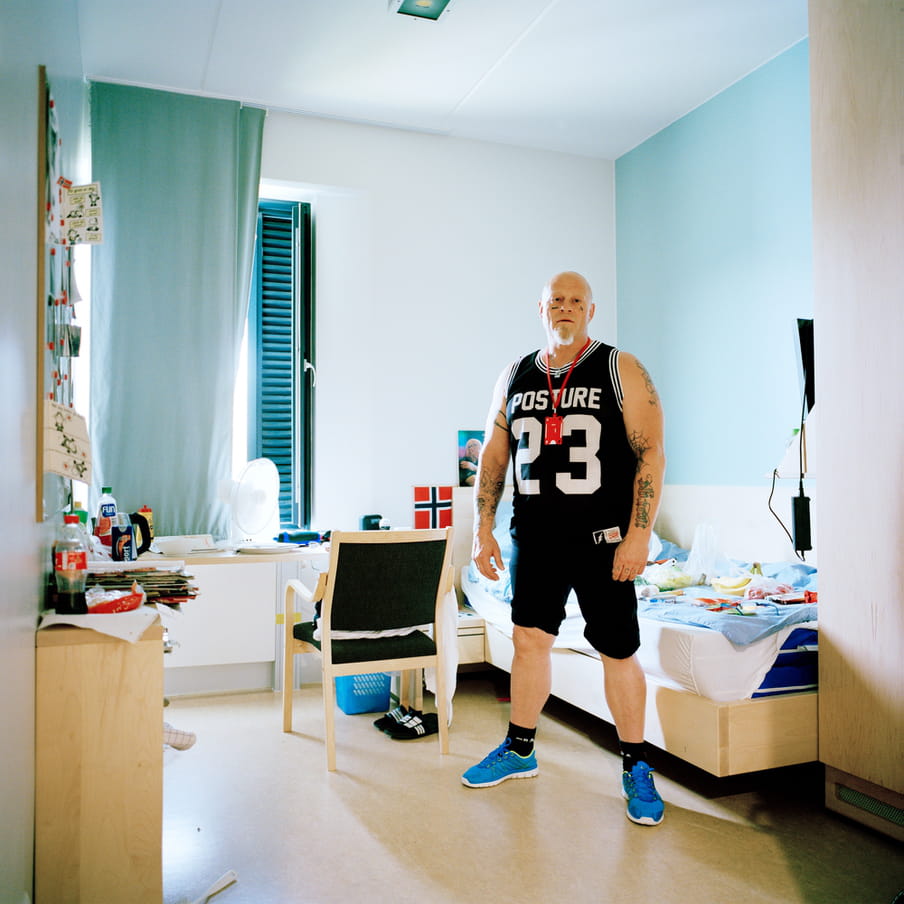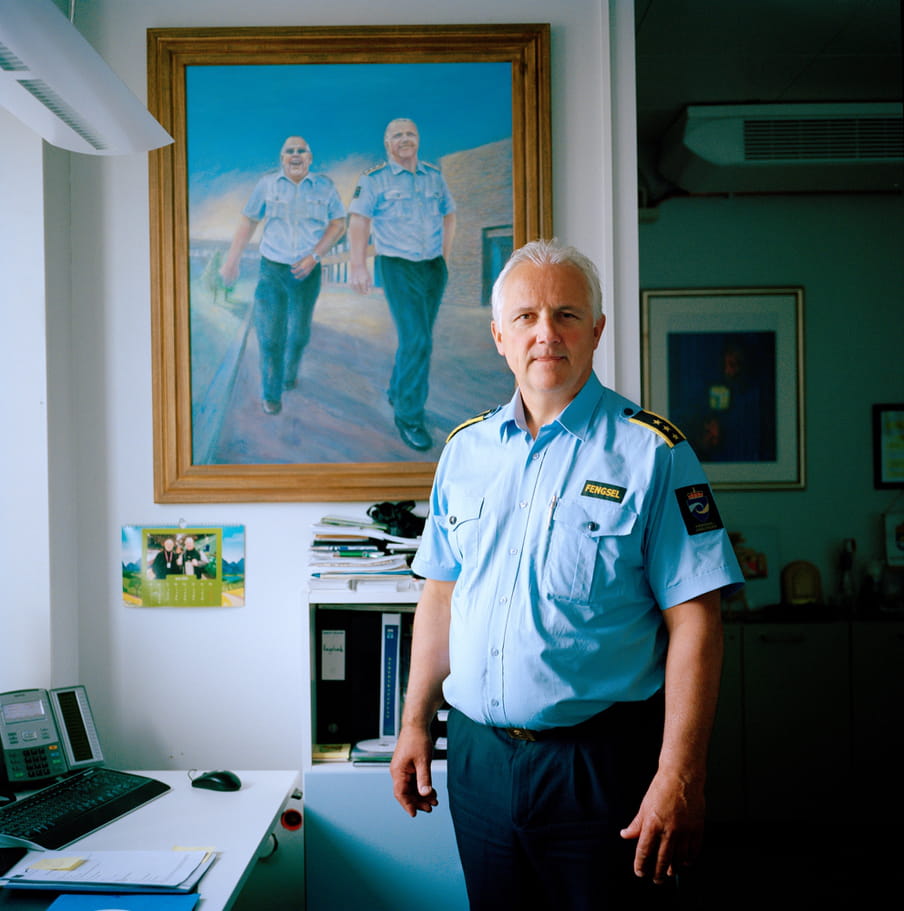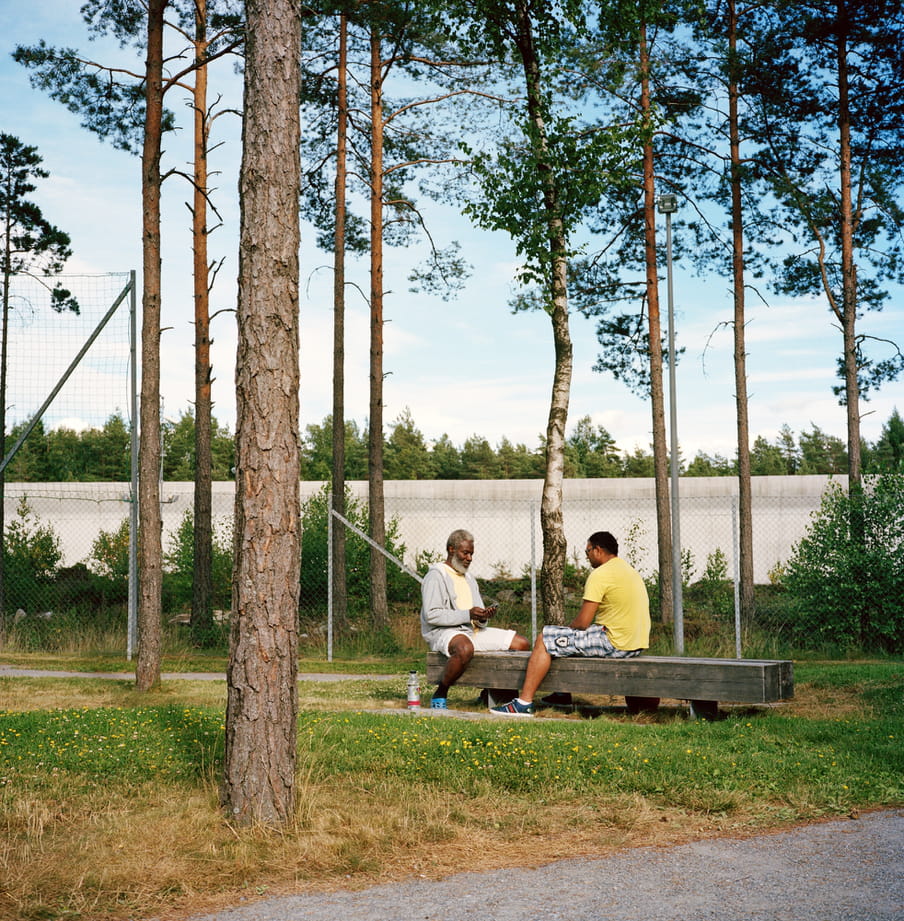In a forest in Norway, about 60 miles south of Oslo, stands one of the strangest prisons in the world. Here, you won’t see cells or bars. You won’t see guards armed with handguns or handcuffs. What you will see is a forest of birch and pine trees, and a rolling landscape criss-crossed by footpaths. Circling it all is a tall steel wall – one of the few reminders that people aren’t here voluntarily. The inmates of Halden prison each have a room of their own. With underfloor heating. A flatscreen TV. A private bathroom.
There are kitchens where the inmates can cook, with porcelain plates and stainless steel knives. Halden also has a library, a climbing wall and a fully equipped music studio where inmates can record their own records. Albums are issued under their own label called – no joke – Criminal Records. To date, three of the prisoners have been contestants on Norwegian Idol, and the first prison musical is in the works.
Halden is a textbook example of what you might call a “non-complementary prison”. Rather than mirroring the detainees’ behaviour, staff turn the other cheek – even to hardcore felons. In fact, the guards don’t carry weapons. “We talk to the guys,” says one guard, “that’s our weapon.” If you’re thinking this must be the softest correctional facility in Norway, you’re wrong. Halden is a maximum-security prison. And with some 250 drug dealers, sexual offenders and murderers, it’s also the second largest prison in the country.

If it’s a softer prison you’re after, that’s just a couple of miles up the road. Bastøy is a picturesque island that houses 115 felons who are sitting out the last years of their sentences. What happens here is analogous to the BBC’s Prison Experiment, that yawn of a reality show that disintegrated into a pacifist commune.
When I first saw pictures of this island, I could scarcely believe my eyes. Inmates and guards flipping burgers together? Swimming? Lounging in the sun? To be honest, it was difficult to tell the prison staff from the inmates. Guards at Bastøy don’t wear uniforms, and everyone there eats meals together, seated around the same table. The island has all kinds of things to do: a cinema, a tanning bed and two ski slopes. Several of the inmates got together and formed a group, the Bastøy Blues Band, which actually scored a spot opening for legendary Texas rockers ZZ Top. There’s also a church, a grocery store and a library.
Bastøy may sound more like a luxury resort, but it’s not quite so laid-back. Inmates have to work hard to keep their community running: they plough and plant, harvest and cook, chop their own wood and do their own carpentry. Everything is recycled and they grow a quarter of their own food. Some inmates even commute from the island to jobs on the mainland, via a ferry service operated by the inmates themselves.
And yes, in the course of their work, the men have access to knives, hammers and other potential murder weapons. If they need to fell a tree, they can use a chainsaw. Even the convicted killer whose murder weapon was – you guessed it – a chainsaw. Have the Norwegians lost it? How naive is it to sentence boatloads of murderers to a holiday resort? Ask Bastøy’s staff, and they’ll tell you that nothing could be more normal. In Norway, where 40% of prison guards are women, all guards complete a two-year training programme: they’re taught that it’s better to make friends with inmates than to patronise and humiliate them.
Norwegians call this “dynamic security”, a term distinct from old-fashioned “static security” – the kind with barred cells, barbed wire and surveillance cameras. In Norway, prison is not about preventing bad behaviour, but preventing bad intentions. Guards understand that it’s their duty to prepare detainees, as best they can, for a normal life. According to this “principle of normality”, life inside the walls should resemble as closely as possible life on the outside.
And, incredibly, it works. Halden and Bastøy are tranquil communities. Whereas traditional penitentiaries are the quintessential total institutions – the kinds of places where bullying is rife – in Norway’s prisons the inmates get along fine. Anytime conflicts arise, both sides must sit down to talk it out, and they can’t leave until they shake hands.
“It’s really very simple,” explains Bastøy’s warden, Tom Eberhardt. “Treat people like dirt, and they’ll be dirt. Treat them like human beings, and they’ll act like human beings.” Even so, I still wasn’t convinced. Rationally, I could understand why a non-complementary approach might work better. Intuitively, it seemed wrong-headed. How would it feel to victims, to know these murderers are being shipped off to Pleasantville?

But when I read Tom Eberhardt’s explanation, it began to make sense. For starters, most inmates will be released sooner or later. In Norway over 90% are back on the streets in less than a year, so obviously they’re going to be other people’s neighbours. As Eberhardt explained to a US journalist, “I tell people, we’re releasing neighbours every year. Do you want to release them as ticking time bombs?” In the end, I reasoned, one thing matters more than anything else: the results. How do these kinds of prisons stack up?
In the summer of 2018, a team of Norwegian and US economists went to work on this question. They looked at the recidivism rate – the chances that someone will commit a repeat offence. According to the team’s calculations, the recidivism rate among former inmates of penitentiaries like Halden and Bastøy is nearly 50% lower than among offenders sentenced to community service or made to pay a fine. I was stunned. Almost 50%? That’s unheard of. It means that, for every conviction, on average 11 fewer crimes are committed in the future. What’s more, the likelihood that an ex-convict will get a job is 40% higher. Being locked up in a Norwegian prison really changes the course of people’s lives.
It’s no coincidence that Norway boasts the lowest recidivism rate in the world. By contrast, the US prison system has among the highest. In the US, 60% of inmates are back in the slammer after two years, compared to 20% in Norway. In Bastøy, it’s even lower – a mere 16% – making this one of the best correctional facilities in Europe, perhaps even the world.
Okay, fine, but isn’t the Norwegian method phenomenally expensive?
At the end of their 2018 article, the economists tallied the costs and benefits. A stay in a Norwegian prison, according to their calculations, costs on average $60,151 per conviction – almost twice as much as in the US. However, because these ex-convicts go on to commit fewer crimes, they also save Norwegian law enforcement $71,226 apiece. And because more of them find employment, they don’t need government assistance and they pay taxes, saving the system on average another $67,086.
Last but not least, the number of victims goes down, which is priceless. Conclusion? Even using conservative estimates, the Norwegian prison system pays for itself more than two times over. Norway’s approach isn’t some naive, socialist aberration. It’s a system that’s better, more humane and less expensive.

On 23 July 1965, a commission of 19 criminologists came together in Washington, DC, convened by President Lyndon B Johnson. Their assignment: over the next two years, develop a radical new vision for the US law enforcement system, spanning everything from policing to detention. These were the turbulent 1960s. A new generation was pounding at the gates of power, crime rates were going up and the old criminal justice system was limping along. The criminologists knew it was time to think big. When they finally came out with their report, it contained more than 200 recommendations. Emergency services needed an overhaul, police training needed to be stepped up and a national emergency hotline was needed – witness the birth of 911. But the most radical recommendations concerned the future of US prisons. On this, the commission didn’t mince words:
‘Life in many institutions is at best barren and futile, at worst unspeakably brutal and degrading. […] the conditions in which they [inmates] live are the poorest possible preparation for their successful reentry into society, and often merely reinforce in them a pattern of manipulation or destructiveness.’
It was time, said the commission, for total reform. No more bars, cells and endless hallways. “Architecturally, the model institution would resemble as much as possible a normal residential setting,” advised the experts. “Rooms, for example, would have doors rather than bars. Inmates would eat at small tables in an informal atmosphere. There would be classrooms, recreation facilities, dayrooms, and perhaps a shop and library.”
It’s a little-known fact that the United States nearly built a prison system similar to what Norway has today. Initial pilots with this “new generation” of prisons were launched in the late sixties. In these facilities, detainees had rooms of their own, with doors opening onto a common area where they could talk, read and play games while an unarmed guard kept an eye on things.
There was soft carpeting, upholstered furniture and real porcelain toilets .
Behold, said the experts: the prison of the future. In hindsight, it’s shocking how fast the tide turned – and what caused it. It started with Philip Zimbardo, who in February 1973 published the first academic article on his Stanford Prison Experiment. Without having ever set foot in a real prison, the psychologist asserted that prisons are inherently brutal, no matter how you dress them up.

This verdict got a warm reception and gained popularity when the infamous Martinson report appeared one year later. The man behind this report, Robert Martinson, was a sociologist at NYU with a reputation as a brilliant if slightly maniacal personality. He was also a man with a mission. In his younger years, Martinson had been a civil rights activist and landed in jail for 39 days (including three in solitary confinement). This awful experience convinced him that all prisons are barbaric places.
In the late sixties, shortly after completing his degree, Martinson was invited to join a big project analysing a wide range of correctional strategies, from courses to therapy to supervision, aimed at helping criminals get on the right track. Working alongside two other sociologists, Martinson gathered data from more than 200 studies done all over the world. Their final report, spanning 736 pages, was unimaginatively titled The Effectiveness of Correctional Treatment: A Survey of Treatment Evaluation Studies.
Since complex studies like this were rarely read by journalists, Martinson also published a short summary of their findings in a popular magazine. Title: What Works? Conclusion: nothing works. “With few and isolated exceptions,” Martinson wrote, “the rehabilitative efforts that have been reported so far have had no appreciable effect on recidivism.” The progressive social scientist hoped – much like Philip Zimbardo – that everyone would realise prisons were pointless places and should all be shut down.
But that’s not what happened.
At first, the media couldn’t get enough of the charismatic sociologist. Newspapers and television programmes gave Martinson a platform to repeat his harsh verdict, while his co-authors stood by tearing their hair out. In reality, the results of 48% of the studies analysed had been positive, showing rehabilitation can work.
The skewed summary of the Martinson report cleared the way for hardliners. Here was the proof, proclaimed conservative policymakers, that some people are simply born bad and stay bad. That the whole concept of rehabilitation defies human nature. Better to lock up these bad apples and throw away the key, they declared. This ushered in a new era of tough, tougher, toughest, and pulled the plug on America’s experiment with a new generation of prisons.
Ironically, Martinson retracted his conclusion a couple years later (“contrary to my previous position, some treatment programs do have an appreciable eff ect on recidivism”). At a seminar in 1978, one astonished professor asked what he was supposed to tell his students. Martinson replied, “Tell them I was full of crap.”
By then, hardly anyone was listening. Martinson wrote one last article owning up to his mistakes, but only an obscure journal would run it. As another scientist observed, it was “probably the most infrequently read article in the criminal justice debate on rehabilitation”. Martinson’s rectification passed unremarked by the newspapers, radio and TV. And it also didn’t make the news when, a few weeks later, the 52-year-old sociologist jumped from the fifteenth storey of his Manhattan apartment block.

By this point, someone else was making headlines: Professor James Q Wilson. His name may not ring any bells, but if we want to understand anything about how the US criminal justice system arrived at the state it’s in today, there’s no getting around this man. In the years after Robert Martinson took his own life, James Wilson would change the course of US history.
A political science professor at Harvard University, Wilson was the kind of guy with opinions about everything – from bioethics to the war on drugs and from the future of the constitutional state to scuba diving. (He also loved being photographed with 20-foot sharks).
But the lion’s share of his life’s work centred on crime. If there was one thing Wilson hated, it was turning the other cheek. He had no use for the new generation of prisons that treated inmates with kindness. Exploring the “origins” of criminal behaviour was a waste of time, he said, and all those liberals who yammered on about the effects of a troubled youth were missing the point. Some people are scum, pure and simple, and the best thing to do is lock them up. Either that or execute them. “It is a measure of our confusion,” wrote the Harvard professor, “that such a statement will strike many enlightened readers today as cruel, even barbaric.”

To Wilson, however, it made perfect sense. His book Thinking About Crime (1975) became a big hit with top dogs in Washington, including President Gerald Ford, who in the year it was published called Wilson’s ideas “most interesting and helpful”. Leading officials rallied around his philosophy.
The best remedy against crime, Professor Wilson patiently instructed, was to put away the criminals. How hard could it be? After reading a number of articles about James Q Wilson’s influence on the justice system, it hit me. I’d heard this name before.
Turns out that in 1982 Wilson came up with another revolutionary idea, which would enter the history books as the broken windows theory. The first time I encountered this theory was in the same book where I’d also first read about Kitty Genovese’s murder (and the 38 bystanders): journalist Malcolm Gladwell’s The Tipping Point .
I remember being riveted by his chapter on Wilson. “If a window in a building is broken and is left unrepaired,” Wilson wrote in a piece for the Atlantic in 1982, “all the rest of the windows will soon be broken.” Sooner or later, if nobody intervenes, the vandals will be followed by squatters. Next, drug addicts might move in, and then it’s only a matter of time before someone gets murdered.
“This is an epidemic theory of crime,” Gladwell observed. Litter on the sidewalks, vagrants on the street, graffiti on the walls: they’re all precursors to murder and mayhem. Even a single broken window sends the message that order is not being enforced, signalling to criminals that they can go even further. So, if you want to fight serious crime, you have to start by repairing broken windows.
At first, I didn’t get it. Why worry about minor offences when people are getting murdered every day? It sounded – Gladwell conceded – “as pointless as scrubbing the decks of the Titanic as it headed toward the icebergs”. But then I read about the first experiments. In the mid-1980s, New York City’s subways were covered in graffiti. The Transit Authority decided something needed to be done, so they hired Wilson’s co-author George Kelling as a consultant. He recommended a large-scale clean-up.
Even trains with just a little graffiti were swiftly sent off to be scrubbed clean. According to the subway director, “We were religious about it.” Then came phase two. Wilson and Kelling’s broken windows theory applied not only to disorder, but to the people who cause it. A city where beggars, hoodlums and panhandlers were allowed to roam at will was setting itself up for much worse. After all, as Wilson noted in 2011, “public order is a fragile thing”. Unlike many other scientists, he put little stock in investigating the structural causes of crime, such as poverty or discrimination.
Instead, he stressed that there’s ultimately only one cause that matters. Human nature.
Most people, Wilson believed, do a simple cost-benefit calculation: does crime pay or not? If police are lax or jails too comfortable, it’s a sure bet more people will choose a life of crime. If crime rates rise, the solution is equally straightforward. You fix it with stronger extrinsic incentives like higher fines, longer jail time and harsher enforcement. As soon as the “costs” of crime go up, demand will drop. One man couldn’t wait to put Wilson’s theory into practice: William Bratton. And Bratton is the final linchpin in our story. In 1990, he was appointed the new chief of the New York City Transit Police. Bratton was a fervent believer in James Wilson’s doctrine. An energetic man, he was famous for constantly handing out copies of the original broken windows article published in the Atlantic. But Bratton wanted to do more than repair windows. He wanted to restore order in New York City, with an iron fist.

As his first target, he picked fare evaders. Subway users who couldn’t present a $1.25 ticket from now on were arrested by transit cops, handcuffed and ceremoniously lined up on the subway platform where everyone could get a good look. The number of arrests made quintupled. This merely whetted Bratton’s appetite. In 1994, he was promoted to city police commissioner, and soon all New Yorkers were getting a taste of Bratton’s philosophy. Initially, his officers were obstructed by rules and protocols, but Bratton swept them away. Now, anyone could be arrested for even the slightest infraction – public drinking, getting caught with a joint, joking around with a cop. In Bratton’s own words, “If you peed in the street, you were going to jail.”
Miraculously, this new strategy appeared to work. Crime rates plummeted. Murder rate? Down 63% between 1990 and 2000. Muggings? Down 64%. Car theft? Down 71% . The broken windows theory once ridiculed by journalists turned out to be a stroke of genius.
Wilson and Kelling became the country’s most esteemed criminologists. Commissioner Bratton made it onto the cover of Time magazine and went on to be appointed chief of the Los Angeles Police Department in 2002 and reappointed by the NYPD in 2014. He came to be revered by generations of police officers, who styled themselves “Brattonistas”. Wilson even credited Bratton with the “biggest change in policing in the country”.

Almost 40 years have passed since the broken windows article first ran in the Atlantic. During that time, Wilson and Kelling’s philosophy has percolated into the farthest reaches of the United States, and well beyond, from Europe to Australia.
In The Tipping Point, Malcolm Gladwell calls the theory a great success, and in my first book I was enthusiastic about it, too. What I failed to realise was that by then few criminologists believed in it any longer. Actually, alarm bells should have started ringing as soon as I read in the Atlantic that Wilson and Kelling’s theory was based on one dubious experiment.
In this experiment, a researcher left a car parked in a respectable neighbourhood for a week. He waited. Nothing happened. Then he returned with a hammer. No sooner had the researcher himself smashed one car window than the floodgates opened. Within a matter of hours, ordinary passers-by had demolished the car.
The researcher’s name? Philip Zimbardo!
Zimbardo’s car experiment, never published in any scientific journal, was the inspiration for the broken windows theory. And just like his Stanford Prison Experiment, this theory has since been thoroughly debunked. We know, for instance, that the “innovative” policing of William Bratton and his Brattonistas was not responsible for the drop in New York City’s crime rates at all. The decline set in earlier, and in other cities, too. Cities like San Diego, where the police left minor troublemakers alone. In 2015, a meta-analysis of 30 studies on broken windows theory revealed that there’s no evidence Bratton’s aggressive policing strategies did anything to reduce crime. Zip, zero, zilch. Neighbourhoods aren’t made safer by issuing parking tickets, just as you couldn’t have saved the Titanic by scrubbing the deck.
My initial reaction was: okay, so arresting bums and drunks doesn’t reduce serious crime. But it’s still good to enforce public order, right?
This throws up a fundamental question. Whose “order” are we talking about? Because as arrests in the Big Apple skyrocketed, so did the reports of police misconduct. By 2014, thousands of demonstrators were taking to the streets of New York and other US cities, including Boston, Chicago and Washington. Their slogan: “Broken windows, broken lives.” This was no exaggeration. In the words of two criminologists, aggressive policing was leading to citations for: … women eating doughnuts in a Brooklyn park; chess players in an Inwood park; subway riders for placing their feet on seats at 4am, and an elderly Queens couple cited for no seatbelts on a freezing cold night while driving to purchase needed prescription drugs. Allegedly, the man was instructed to walk home to secure identification – a few blocks from the pharmacy. When he returned to the pharmacy, the officers already wrote the ticket using a prescription bottle as identification. The elderly man’s subsequent heart attack led to his death.

What had sounded so good in theory boiled down to more and more frivolous arrests. Commissioner Bratton became obsessed with statistics, and so did his officers. Those who could present the best figures were promoted, while those who lagged behind were called to task. The result was a quota system in which officers felt pressured to issue as many fines and rack up as many citations as possible. They even began fabricating violations. People talking in the street? Arrest ’em for blocking a public road. Kids dancing in the subway? Book ’em for disturbing the peace.
Serious crimes were an entirely different story, investigative journalists later discovered. Officers were pressured to tone down their reports or skip them altogether, to avoid making departmental figures look bad. There are even cases of rape victims who were subjected to endless questioning in an attempt to trip them up on tiny inconsistencies. Then the incident wouldn’t be included in the data.
On paper, it all looked fantastic. Crime had taken a nosedive, the number of arrests were sky high and Commissioner Bratton was the hero of New York. In reality, criminals walked free while thousands of innocent people became suspects. To this day, police departments across the country still swear by Bratton’s philosophy – which is why scientists continue to consider US police statistics unreliable.
There’s more. The broken windows strategy has also proven synonymous with racism. Data show that a mere 10% of people picked up for misdemeanours are white. Meanwhile, there are black teenagers who get stopped and frisked on a monthly basis – as they have been for years – despite never having committed an offence. Broken windows has poisoned relations between law enforcement and minorities, saddled untold poor with fines they can’t pay and also had fatal consequences, as in the case of Eric Garner, who died in 2014 while being arrested for allegedly selling loose cigarettes. “Every time you see me, you want to mess with me,” Garner protested. “I’m tired of it … Please just leave me alone. I told you the last time, please just leave me alone.”
Instead, the officer wrestled him to the ground and put him in a chokehold. Garner’s last words were “I can’t breathe.” Only now, years after reading Malcolm Gladwell’s book, have I come to realise the broken windows theory is underpinned by a totally unrealistic view of human nature. It’s yet another variant on veneer theory. It made police in New York treat ordinary people like potential criminals: the smallest misstep could supposedly be the first on a path to far worse. After all, our layer of civilisation is tenuously thin. Officers, meanwhile, were being managed as though they possessed no judgement of their own. No intrinsic motivation.
They were drilled by their superiors to make their departments look as good as possible on paper. Does this mean we should forget about fixing actual broken windows? Of course not. It’s an excellent idea to repair windows, spruce up houses and listen to local people’s concerns. Just as an orderly prison radiates trust, a tidy neighbourhood feels much safer. And after you fix the windows, you can throw them wide open. But Wilson and Kelling’s argument wasn’t primarily about broken windows or poorly lit streets. The “broken window” was a misleading metaphor. In practice, it was ordinary people who were being registered, restrained and regulated.
Professor Wilson was steadfast to the end, maintaining right up to his death in 2012 that the Brattonista approach was a huge success. Meanwhile, his co-author was plagued by mounting doubts. George Kelling felt the broken windows theory had been too often misapplied. His own concern had always been about the broken windows themselves, not the arrest and incarceration of as many black and brown people as possible.
“There’s been a lot of things done in the name of Broken Windows that I regret,” Kelling admitted in 2016. When he began hearing police chiefs all over the country invoke his theory, two words flashed across his mind: “Oh shit."
What would happen if we turned the broken windows theory around? If we can redesign prisons, could we do the same with police departments?
I think we can. In Norway – where else – there’s already a long tradition of community policing, a strategy that assumes most folks are decent, law-abiding citizens. Officers work to win community trust, informed by the idea that if people know you, they’ll be more likely to help out. Neighbours will give more tips, and parents will be quicker to call if their child seems to be heading down the wrong path. Back in the 1970s, Elinor Ostrom – the economist who researched the commons – conducted the largest study ever into police departments in the United States. She and her team discovered that smaller forces invariably outperform bigger ones. They’re faster on the scene, solve more crimes, have better ties with the neighbourhood, and all at a lower cost. Better, more humane, less expensive.

In Europe, the philosophy of community policing has been around a while. Officers are used to coordinating with social services and even consider what they do a kind of social work. They’re also well trained. In the US, the average police training programme lasts just nineteen weeks, which is unthinkable in most of Europe. In countries like Norway and Germany, law enforcement training takes more than two years. But some US cities are changing their approach. The people of Newark, New Jersey, elected a new, black mayor in 2014, and he had a clear vision of what modern policing in the city should look like. It requires officers, he said, “who know people’s grandmothers, who know the institutions of the community, who look at people as human beings […] that’s the beginning of it. If you don’t look at the people you’re policing as human, then you begin to treat them inhumanely.”
Could we take the principle of turning the other cheek even further? Absurd as the question may sound, I couldn’t help wondering: Could a non-complementary strategy also work in the war on terror?
In my search for an answer I discovered that this strategy has been tried already – in fact, in my own country. Among experts, it’s even called the Dutch Approach. It began back in the seventies, when the Netherlands was confronted with a violent wave of leftist terrorism. The government didn’t enact new security laws, however, and the media did as law enforcement asked and limited coverage. While West Germany, Italy and the United States brought out the big guns – helicopters, road blocks, troops – the Netherlands refused to give terrorists the platform they wanted.
In fact, the police refused to even use the word “terrorism”. They preferred “violent political activism” or plain old “criminals”. Meanwhile, Dutch intelligence was busy behind the scenes, infiltrating extremist groups. They set their sights specifically on terrorists – sorry, criminals – without turning whole segments of the population into suspects.
This led to some comical situations, like a tiny Red Youth cell in which three of the four members were undercover agents. Carrying out attacks turned out to be pretty difficult when there was always someone off taking a bathroom break or holding the map upside down.
“A behind-the-scenes, timely, cautious counterterrorism policy,” concludes a Dutch historian, “brought the spiralling violence to a standstill.” When some of the Red Youth visited a terrorist training camp in Yemen, the Dutch terrorists were shocked by the intensity of the German and Palestinian fighters. It was downright scary. As one Dutch member later put it, “They took all the fun out of it.”
A more recent example of a turn-the-other-cheek approach comes from the Danish city of Aarhus. In late 2013, the police decided not to arrest or jail young Muslims who wanted to go and fight in Syria but to offer them a cup of tea instead. And a mentor. Family and friends were mobilised to make sure these teenagers knew there were people who loved them. At the same time, police strengthened ties with the local mosque. More than a few critics called the Aarhus approach weak or naive. But in truth, the police chose a bold and difficult strategy. “What’s easy,” scoffed the police superintendent, “is to pass tough new laws.”
Harder is to go through a real process with individuals: a panel of experts, counselling, healthcare, assistance getting back into education, with employment, maybe accommodation […] We don’t do this out of political conviction; we do it because we think it works.’
And work it did. While in other European cities the exodus continued unabated, the number of jihadists travelling to Syria from Aarhus declined from thirty in 2013 to one in 2014 and two in 2015. ‘Aarhus is the first, to my knowledge, to grapple with [extremism] based on sound social psychology evidence and principles,’ notes a University of Maryland psychologist.
And then there’s Norway. People there managed to keep a cool head even after the most horrific attack in the country’s history. After the 2011 bloodbath perpetrated by rightwing extremist Anders Breivik, the country’s prime minister declared, “Our response is more democracy, more openness, and more humanity.” This kind of response often gets you accused of looking the other way, of choosing the easy path. But more democracy, more openness and more humanity are precisely what’s not easy. On the contrary, tough talk, retaliation, shutting down borders, dropping bombs, dividing up the world into the good guys and the bad – that’s easy. That’s looking the other way.

There are some moments when it becomes impossible to look away. When the truth refuses to be ignored. In October 2015, a delegation of North Dakota’s top prison officials experienced just such a moment. It happened during a work visit to Norway. For those who don’t know, North Dakota is a sparsely populated, conservative state.
The incarceration rate is eight times as high as in Norway. And the prisons? They’re old-fashioned holding pens; all long corridors, bars and stern guards. The American officials didn’t expect to learn much from their trip. “I was arrogant,” one said later. “What was I really going to see other than what I call the IKEA prison?”
But then they saw the prisons. Halden. Bastøy. The tranquillity. The trust. The way inmates and guards interact. Seated at the bar of the Radisson Hotel in Oslo one evening was the director of the North Dakota Department of Corrections. Leann Bertsch – known among her colleagues as tough and unbending – began to cry. “How did we think it was okay to put human beings in cagelike settings?”
Between 1972 and 2007, the number of people incarcerated in the United States, corrected for population growth, grew by more than 500%. And those inmates are locked up for an average of 63 months – seven times longer than in Norway. Today, almost a quarter of the world’s prison population is behind American bars.

This mass incarceration is the result of intentional policy. The more people you lock up, Professor James Wilson and his followers believed, the lower the crime rate. But the truth is that many US prisons have devolved into training grounds for criminals – costly boarding schools that produce more accomplished crooks. A few years ago, it came out that a mega-facility in Miami was cramming as many as 24 inmates into a single cell, from which they were let out for one hour twice a week. The result was a “brutal gladiatorial code of fighting” among inmates.
Individuals released from these kinds of institutions are a genuine danger to society. “The vast majority of us become exactly who we are told we are,” says one former California prison inmate: “violent, irrational, and incapable of conducting ourselves like conscious adults.”
When Leanne Bertsch returned from Norway, she realised things had to change in North Dakota prisons. She and her team formulated a new mission: “To implement our humanity.”
Step one? Shelve the broken windows strategy. Where before there had been regulations covering over 300 violations – not tucking in your shirt, for instance, which could land you in solitary confinement – now all those nitpicky rules were scrapped.
Next, a new protocol was drawn up for guards. Among other things, they had to have at least two conversations a day with inmates. This was a major transition and met with considerable resistance. “I was scared to death,” one of the guards recalled. “I was scared for staff. I was scared for the facility. I was scared when we talked about specific guys leaving, and I was wrong.”
As the months passed, the guards began to take more pleasure in their work. They started a choir and painting classes. Staff and inmates began playing basketball together. And there was a notable reduction in the number of incidents. Before, there had been incidents “at least three or four times a week,” according to one guard. “Someone trying to commit suicide, or someone trying to flood their cell, or being completely disorderly. We haven’t hardly had any of that this year.”
Top officials from six other US states and counting have since taken trips to Norway. Director Bertsch in North Dakota continues to stress that reform is a matter of common sense. Locking away whole swaths of the population is just a bad idea. And the Norwegian model is demonstrably better. Less expensive. More realistic.
“I’m not a liberal,” swears Bertsch. “I’m just practical.”
Translated from the Dutch by Elizabeth Manton and Erica Moore.
Rutger Bregman’s book Humankind is available from Little, Brown in North America and Bloomsbury in the UK.

Dig deeper
 Has the time finally come for universal basic income?
In the past few weeks, calls for a universal basic income have been louder than ever. Even the US is sending cheques to most citizens. And rightly so – the coronavirus pandemic requires radical action. Seven years ago, I wrote for the first time about a forgotten idea whose time has come.
Has the time finally come for universal basic income?
In the past few weeks, calls for a universal basic income have been louder than ever. Even the US is sending cheques to most citizens. And rightly so – the coronavirus pandemic requires radical action. Seven years ago, I wrote for the first time about a forgotten idea whose time has come.
 Why we can be hopeful about criminal justice in the US (even if it still jails the most people)
Just 30 years ago, getting cross-party support to change sentencing, policing or the death penalty would have been almost unthinkable. Today, though progress remains slow, the costs of tough-on-crime policies are prompting a change of heart.
Why we can be hopeful about criminal justice in the US (even if it still jails the most people)
Just 30 years ago, getting cross-party support to change sentencing, policing or the death penalty would have been almost unthinkable. Today, though progress remains slow, the costs of tough-on-crime policies are prompting a change of heart.


